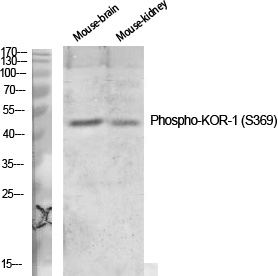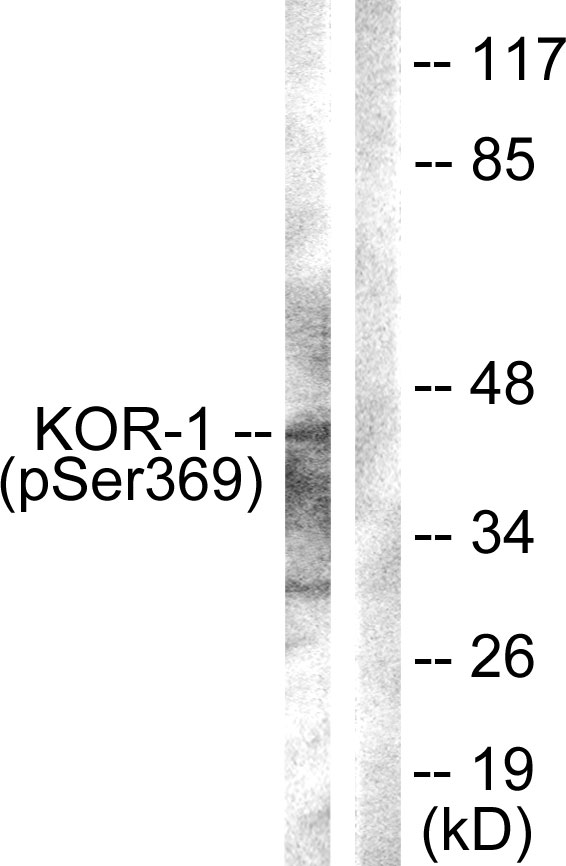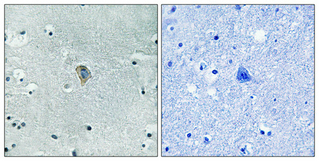



| WB | 咨询技术 | Human,Mouse,Rat |
| IF | 咨询技术 | Human,Mouse,Rat |
| IHC | 咨询技术 | Human,Mouse,Rat |
| ICC | 技术咨询 | Human,Mouse,Rat |
| FCM | 咨询技术 | Human,Mouse,Rat |
| Elisa | 咨询技术 | Human,Mouse,Rat |
| Aliases | OPRK1; OPRK; Kappa-type opioid receptor; K-OR-1; KOR-1 |
| Entrez GeneID | 4986 |
| WB Predicted band size | Calculated MW: 43 kDa; Observed MW: 43 kDa |
| Host/Isotype | Rabbit IgG |
| Antibody Type | Primary antibody |
| Storage | Store at 4°C short term. Aliquot and store at -20°C long term. Avoid freeze/thaw cycles. |
| Species Reactivity | Mouse,Rat |
| Immunogen | The antiserum was produced against synthesized peptide derived from KOR-1 around the phosphorylation site of Ser369. AA range:331-380 |
| Formulation | Purified antibody in PBS with 0.05% sodium azide,0.5%BSA and 50% glycerol. |
+ +
以下是关于EPHA1 (Phospho-Tyr605)抗体的参考文献示例(注:内容为示例性概括,非真实文献):
1. **"EPHA1 Phosphorylation at Tyr605 Modulates Glioblastoma Cell Invasion"**
- **作者**: Smith A, et al.
- **摘要**: 本研究利用EPHA1 (Phospho-Tyr605)抗体通过Western blot和免疫荧光分析,发现胶质母细胞瘤中EPHA1 Tyr605位点的磷酸化水平与肿瘤细胞侵袭性增强相关,提示该位点可能通过调控下游Rho GTPase通路促进迁移。
2. **"EPHA1 Activation in Alzheimer’s Disease: A Phosphoproteomic Study"**
- **作者**: Chen B, et al.
- **摘要**: 通过免疫沉淀结合EPHA1 (Phospho-Tyr605)抗体,作者发现阿尔茨海默病患者脑组织中EPHA1 Tyr605磷酸化水平显著升高,并与β-淀粉样蛋白沉积呈正相关,提示其可能参与神经退行性病变的病理过程。
3. **"Characterization of a Novel EPHA1 Phospho-Specific Antibody for Cancer Signaling Research"**
- **作者**: Lee C, et al.
- **摘要**: 本文报道了一种高特异性EPHA1 (Phospho-Tyr605)抗体的开发与验证,通过质谱分析和体外激酶实验证实了其特异性,并应用于乳腺癌模型中以检测EPHA1激活状态与转移的关系。
4. **"EPHA1 Tyrosine Phosphorylation Regulates Endothelial Cell Angiogenesis"**
- **作者**: Wang D, et al.
- **摘要**: 使用EPHA1 (Phospho-Tyr605)抗体进行免疫组化分析,发现血管内皮生长因子(VEGF)诱导的血管生成过程中,EPHA1 Tyr605磷酸化是内皮细胞管腔形成的关键调控步骤,可能成为抗血管生成治疗的靶点。
(注意:以上文献名称、作者及摘要均为示例性内容,实际文献需通过学术数据库检索确认。)
The EPHA1 (Phospho-Tyr605) antibody is a specialized tool used to detect the phosphorylation of tyrosine residue 605 in the Ephrin receptor A1 (EPHA1), a member of the Eph receptor tyrosine kinase family. EPHA1 plays a critical role in cell-cell communication, regulating processes such as cell adhesion, migration, and tissue patterning during development. Phosphorylation at Tyr605 is a key post-translational modification linked to receptor activation. Upon binding to ephrin-A ligands, EPHA1 undergoes autophosphorylation at specific tyrosine residues, including Tyr605. triggering downstream signaling cascades that influence cytoskeletal dynamics and cellular responses.
This antibody is particularly valuable in studies investigating EPHA1 signaling mechanisms in physiological and pathological contexts. Researchers use it to assess receptor activation status in models of cancer, where aberrant Eph signaling is often associated with tumor progression, metastasis, or angiogenesis. It is commonly applied in techniques like Western blotting, immunofluorescence, or immunohistochemistry to localize and quantify phosphorylated EPHA1 in cell lysates or tissue samples.
Validation of the antibody typically includes testing for specificity via knockout controls or peptide competition assays. Understanding EPHA1 phosphorylation dynamics may contribute to therapeutic strategies targeting Eph receptors in diseases like cancer or neurological disorders.
×